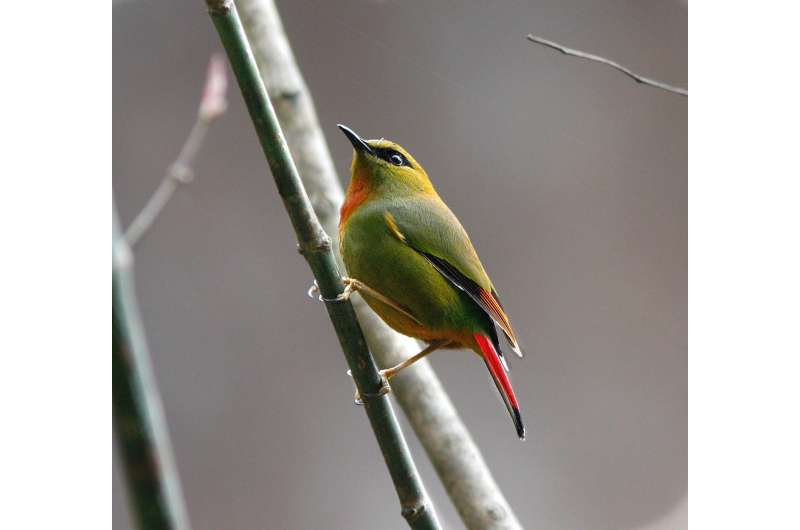Similarities in species diversity and range in both terrestrial birds and marine bivalves

Marine and terrestrial species inhabit vastly different ecosystems, but they share one of the primary patterns of biodiversity on the planet. The numbers of species of both groups increase toward the equator, with fewer species in temperate, higher latitudes and more in the tropics.
An unusual new study led by researchers from the University of Chicago shows that while terrestrial birds and marine bivalves—animals such as scallops, mussels, cockles, and oysters—share this pattern of species richness across latitudes as well, they arrive there quite differently.
Birds have a large number of species that inhabit only a narrow band of latitude within the tropics, and more broad-ranging species in temperate regions. Bivalves, however, have their broadest-ranging species in the tropics. Despite this difference, in both groups the more diverse evolutionary lineages—the ones containing more species—had the best chance of producing a individuals that could cross the tropical-temperate boundary that serves as a strong barrier for many species.
The study, published May 4, 2016, in the Proceedings of the Royal Society B, is one of the first of its kind to compare such disparate marine and terrestrial ecosystems, and shows that evolutionary and biogeographic dynamics appear to be closely tied.
"It's extremely unusual to study a really big diversity pattern in both a marine and terrestrial group using exactly the same methods," said paleontologist David Jablonski, the William R. Kenan Jr. Distinguished Service Professor in Geophysical Sciences at UChicago. "This comparison seemed a good way to get at truly general rules of how biodiversity works."
The study was a collaborative effort between Jablonski, who studies large-scale patterns of evolution in marine life, and biologist Trevor Price, a professor in the Department of Ecology and Evolution who studies speciation and spatial patterns in birds.
Jablonski, Price, students and postdocs in their respective labs, plus a Danish colleague and his student, compiled more than 60,000 occurrence records of marine bivalves and 2.7 million records of birds. After normalizing and analyzing the data, they found that at the level of lineages, both birds and bivalves at first seemed to follow a pattern known as Rapoport's rule. Coined by Argentinian ecologist Eduardo Rapoport in 1975, Rapoport's rule states that latitudinal ranges of animals tend to be smaller in the tropics, and larger at higher latitudes.
Rapoport's rule held true when looking at an average range size in the tropics or high latitudes, but the researchers found a more complex underlying distribution of range sizes. Both groups of animals showed a nested pattern of distribution, with narrow-ranging lineages concentrated in the tropics, and broad-ranging lineages that extended from the tropics into higher latitudes.
"This was tricky," Jablonski said. "We couldn't just take an average at each latitude, we needed to look at the whole picture to see what was going on."
Species diversification seemed to drive expansion of a lineage to novel latitudes, across the sharp climatic divide between tropical and temperate zone. Many lineages seem to be confined to single climate zone, but more diverse lineages in both groups were more likely to expand from one climate zone to the other.
"You could argue that it's like a lottery, and the more tickets you have, the more likely you are to win. The more species you generate, one of them may be more likely to have just the right combination of traits that allows it to cross that tropical-temperate boundary," Jablonski said. "This suggests an important general rule for the way lineages expand their ranges over time, even across major climatic barriers."
The study is a product of the UChicago Committee on Evolutionary Biology (CEB), a unique graduate program that gives PhD students an opportunity to collaborate across the university's biological sciences, physical sciences, social sciences, and humanities divisions, along with outside institutions including Argonne National Laboratory, Brookfield Zoo, Chicago Botanic Garden, the Field Museum, Lincoln Park Zoo, and Morton Arboretum.
Jablonski said the CEB provides an opportunity to circumvent traditional academic structures and collaborate across disciplines to study broad questions in biodiversity and many other fields.
"It's really valuable to take a step back and pull together multiple groups to see what we have in common," he said. "This project seemed like a great way to get beyond the specifics of individual systems and really drill down to the real generalities, to try to understand how the world works."
More information: Unifying latitudinal gradients in range size and richness across marine and terrestrial systems, Proceedings of the Royal Society B, DOI: 10.1098/rspb.2015.3027
Journal information: Proceedings of the Royal Society B
Provided by University of Chicago Medical Center

















